-
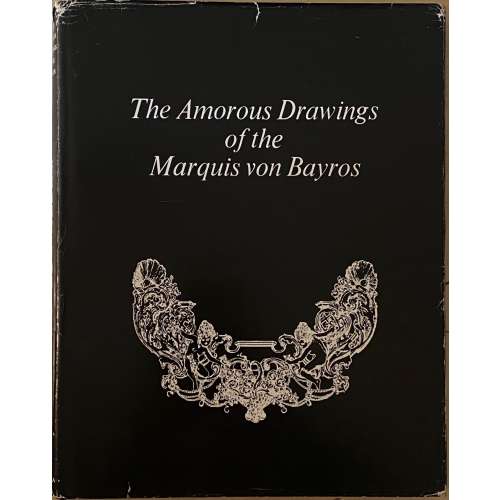 Title: The amorous drawings | of the | Marquis von Bayros | Part I | THE CYTHERA PRESS | NEW YORK Pagination: [1-3] 4-238 [2], 292 illustrations within pagination. Content: Preface by Wilhelm M. Busch, biography of Von Bayros by Johann Pilz, two essays by Von Bayros; 292 illustrations by Marquis Franz von Bayros; Part I and II in one volume. Exterior: 33 x 26 cm, publisher's black cloth with white lettering and fac-simile drawing of von Bayros to cover, white lettering to spine, similarly designed DJ. The original Cythera Press hardcover edition of 1968.
Title: The amorous drawings | of the | Marquis von Bayros | Part I | THE CYTHERA PRESS | NEW YORK Pagination: [1-3] 4-238 [2], 292 illustrations within pagination. Content: Preface by Wilhelm M. Busch, biography of Von Bayros by Johann Pilz, two essays by Von Bayros; 292 illustrations by Marquis Franz von Bayros; Part I and II in one volume. Exterior: 33 x 26 cm, publisher's black cloth with white lettering and fac-simile drawing of von Bayros to cover, white lettering to spine, similarly designed DJ. The original Cythera Press hardcover edition of 1968. -
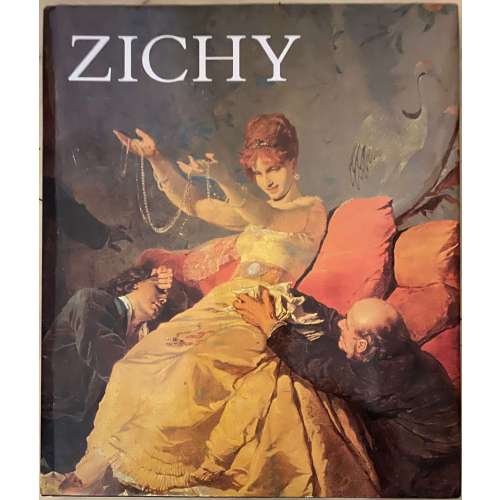 Title: ZICHI | A bevezető tanulmányt írta | és a képeket válogatta | GELLÉR KATALIN | Introduced and selected by | KATALIN GELLÉR | CORVINA || Pagination: [1-4] 5-44 + 34 leaves of illustrations, (66 plates). Exterior: 32.5 x 28 cm, hardcover, original dark green cloth with silver lettering to spine, pictorial DJ. Text in Hungarian and English. Artist: Mihály Zichy [Michael von Zichy] (Hungarian, 1827 – 1906).
Title: ZICHI | A bevezető tanulmányt írta | és a képeket válogatta | GELLÉR KATALIN | Introduced and selected by | KATALIN GELLÉR | CORVINA || Pagination: [1-4] 5-44 + 34 leaves of illustrations, (66 plates). Exterior: 32.5 x 28 cm, hardcover, original dark green cloth with silver lettering to spine, pictorial DJ. Text in Hungarian and English. Artist: Mihály Zichy [Michael von Zichy] (Hungarian, 1827 – 1906). -
![Joseph Burke and Colin Caldwell. Hogarth: The Complete Engravings. – Harry N. Abrams, Inc., Publishers, New York, [1968].](https://varshavskycollection.com/wp-content/uploads/2021/02/LIB-2111.2019-a-scaled-500x500.jpeg) Title: Joseph Burke and Colin Caldwell | Hogarth | The Complete Engravings | Harry N. Abrams, Inc., Publishers, New York || Pagination: [1-4] 5-30 (text), unpaginated: 128 leaves of illustrations (267 plates), 16 leaves of descriptions, folding list of plates: total number of leaves 160, incl. one folding. Exterior: 34 x 24.5 cm, hardbound; original brown cloth, silver lettering to spine, pictorial DJ. Harry N. Abrams (British-American, 1905 – 1979). Joseph Terence Burke (British, 1913 – 1992). Colin Caldwell (British, 1913 – 1989).
Title: Joseph Burke and Colin Caldwell | Hogarth | The Complete Engravings | Harry N. Abrams, Inc., Publishers, New York || Pagination: [1-4] 5-30 (text), unpaginated: 128 leaves of illustrations (267 plates), 16 leaves of descriptions, folding list of plates: total number of leaves 160, incl. one folding. Exterior: 34 x 24.5 cm, hardbound; original brown cloth, silver lettering to spine, pictorial DJ. Harry N. Abrams (British-American, 1905 – 1979). Joseph Terence Burke (British, 1913 – 1992). Colin Caldwell (British, 1913 – 1989). -
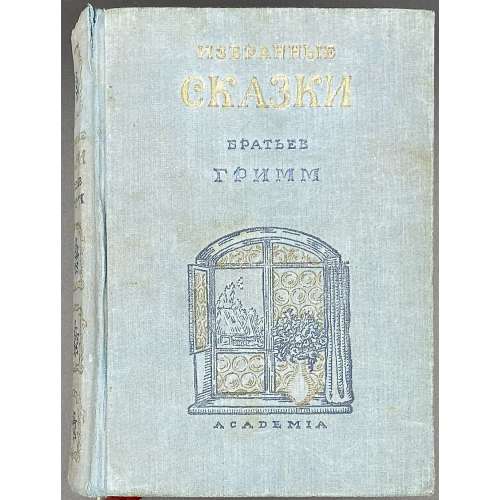 Title: ИЗБРАННЫЕ | СКАЗКИ | БРАТЬЕВ ГРИММ | Перевод | Григория Петникова | {device} | ACADEMIA | Москва—Ленинград | 1937 || Title verso: Kinder- und Hausmärchen | gesammelt durch die | Brüder Grimm | иллюстрации с рисунков Ракхама 1900 г. | Переплет, контр-титул, фронтиспис, заставка и концовка А. Д. Силина. Pagination: [1-4] 5-634 [2] ; b/w illustrations in text, 2 colour plates. Collation: 8vo; [1]8 2-398 406. Print run: 15,300 copies. Binding: publisher’s blue cloth stamped with lettering and elements of design to cover and spine, pictorial endleaves. Петников, Григорий Николаевич (Russian, 1894 – 1971) Силин, Александр Дмитриевич (Russian, 1883 – 1942)
Title: ИЗБРАННЫЕ | СКАЗКИ | БРАТЬЕВ ГРИММ | Перевод | Григория Петникова | {device} | ACADEMIA | Москва—Ленинград | 1937 || Title verso: Kinder- und Hausmärchen | gesammelt durch die | Brüder Grimm | иллюстрации с рисунков Ракхама 1900 г. | Переплет, контр-титул, фронтиспис, заставка и концовка А. Д. Силина. Pagination: [1-4] 5-634 [2] ; b/w illustrations in text, 2 colour plates. Collation: 8vo; [1]8 2-398 406. Print run: 15,300 copies. Binding: publisher’s blue cloth stamped with lettering and elements of design to cover and spine, pictorial endleaves. Петников, Григорий Николаевич (Russian, 1894 – 1971) Силин, Александр Дмитриевич (Russian, 1883 – 1942) -
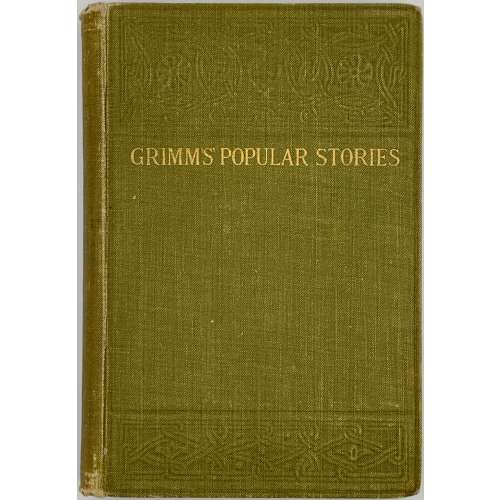 Title: OXFORD EDITION | POPULAR STORIES | COLLECTED BY | THE BROTHERS GRIMM | A REPRINT OF THE FIRST ENGLISH EDITION | WITH TWENTY-TWO ILLUSTRATIONS | BY GEORGE CRUIKSHANK | {publisher’s device} | HENRY FROWDE | LONDON, EDINBURGH, GLASGOW | NEW YORK AND TORONTO | 1905 || Pagination: [i, ii] – frontis., [iii-iv]– t.p. / imprint. [v] – preface, vi-xvii [xviii blank], [2] [1] 2-403 [404], plates included in pagination, pp. 379-403 – notes. Collation: a8 b2 B-Z8 Aa-Cc8 Dd2. Binding:1 9 x 13 cm, olive green cloth blind-stamped in art nouveau style and lettered in gilt to cover and spine: GRIMMS’ POPULAR STORIES. Aubergine pencil inscription to front pastedown: C. Grant Robertson | All Souls | 1905: Provenance: Sir Charles Grant Robertson CVO (British, 1869 – 1948) who was a British academic historian, a Fellow of All Souls College, Oxford, and Vice-chancellor of the University of Birmingham.
Title: OXFORD EDITION | POPULAR STORIES | COLLECTED BY | THE BROTHERS GRIMM | A REPRINT OF THE FIRST ENGLISH EDITION | WITH TWENTY-TWO ILLUSTRATIONS | BY GEORGE CRUIKSHANK | {publisher’s device} | HENRY FROWDE | LONDON, EDINBURGH, GLASGOW | NEW YORK AND TORONTO | 1905 || Pagination: [i, ii] – frontis., [iii-iv]– t.p. / imprint. [v] – preface, vi-xvii [xviii blank], [2] [1] 2-403 [404], plates included in pagination, pp. 379-403 – notes. Collation: a8 b2 B-Z8 Aa-Cc8 Dd2. Binding:1 9 x 13 cm, olive green cloth blind-stamped in art nouveau style and lettered in gilt to cover and spine: GRIMMS’ POPULAR STORIES. Aubergine pencil inscription to front pastedown: C. Grant Robertson | All Souls | 1905: Provenance: Sir Charles Grant Robertson CVO (British, 1869 – 1948) who was a British academic historian, a Fellow of All Souls College, Oxford, and Vice-chancellor of the University of Birmingham. -
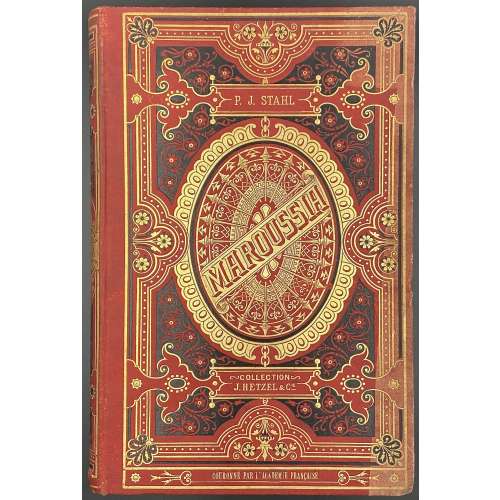 Title: MAROUSSIA | PAR | P.-J. STAHL | D'APRÈS UNE LÉGENDE DE MARKOWOVZOK | DESSINS PAR TH. SCHULER | GRAVURES PAR PANNEMAKER | {vignette} | BIBLIOTHÈQUE | D'ÉDUCATION ET DE RÉCRÉATION | J. HETZEL ET Cie, 18, RUE JACOB | PARIS | Tous droits de reproduction et de traduction réservés || Pagination: [2] – t.p. / blank, [1, 2] – dedication / blank, [3] 4-272, [1] 2-11 [12] – publisher’s advert.; Frontispiece and 22 leaves of wood-engraved plates by F. Pannemaker after Th. Schuler, extraneous to collation, woodcut head- and tailpieces, vignettes in the text by Charles Baude. Collation: 4to; 1-344, + 6 leaves of publisher's advertisement. Binding: “Cartonnage Hetzel” – red cloth stamped in gilt and black with the elements of design to spine, front and back, publisher's device to back, AEG. Author and publisher: Pierre-Jules Hetzel [P.-J. Stahl] (French, 1814 – 1886). Artist: Jules Théophile Schuler (French, 1821 – 1878). Engravers: Adolphe François Pannemaker (Belgian-French, 1822 – 1900) and Charles Baude (French, 1853 – 1935). Author of the legend: Markowovzok [Marko Vovchok; Марко́ Вовчо́к, real name Mariya Vilinskаya; Мария Александровна Вилинская] (Ukrainian, 1833 – 1907). Series: Collection Hetzel (stamped on the front board). Typographie A. Lahure (Paris), Alexis Lahure (French, 1849 – 1929). MAROUSSIA – The French version of the Ukrainian name Маруся.
Title: MAROUSSIA | PAR | P.-J. STAHL | D'APRÈS UNE LÉGENDE DE MARKOWOVZOK | DESSINS PAR TH. SCHULER | GRAVURES PAR PANNEMAKER | {vignette} | BIBLIOTHÈQUE | D'ÉDUCATION ET DE RÉCRÉATION | J. HETZEL ET Cie, 18, RUE JACOB | PARIS | Tous droits de reproduction et de traduction réservés || Pagination: [2] – t.p. / blank, [1, 2] – dedication / blank, [3] 4-272, [1] 2-11 [12] – publisher’s advert.; Frontispiece and 22 leaves of wood-engraved plates by F. Pannemaker after Th. Schuler, extraneous to collation, woodcut head- and tailpieces, vignettes in the text by Charles Baude. Collation: 4to; 1-344, + 6 leaves of publisher's advertisement. Binding: “Cartonnage Hetzel” – red cloth stamped in gilt and black with the elements of design to spine, front and back, publisher's device to back, AEG. Author and publisher: Pierre-Jules Hetzel [P.-J. Stahl] (French, 1814 – 1886). Artist: Jules Théophile Schuler (French, 1821 – 1878). Engravers: Adolphe François Pannemaker (Belgian-French, 1822 – 1900) and Charles Baude (French, 1853 – 1935). Author of the legend: Markowovzok [Marko Vovchok; Марко́ Вовчо́к, real name Mariya Vilinskаya; Мария Александровна Вилинская] (Ukrainian, 1833 – 1907). Series: Collection Hetzel (stamped on the front board). Typographie A. Lahure (Paris), Alexis Lahure (French, 1849 – 1929). MAROUSSIA – The French version of the Ukrainian name Маруся. -
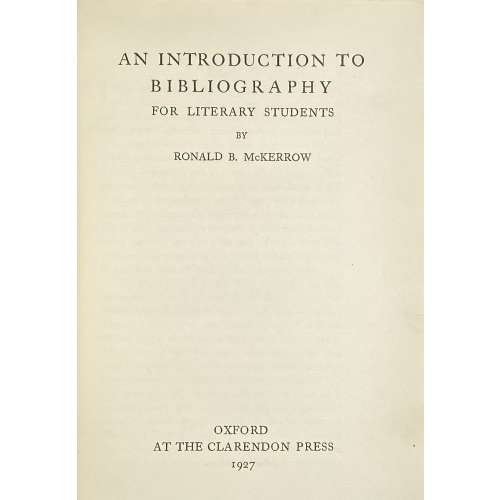 Title: AN INTRODUCTION TO | BIBLIOGRAPHY | FOR LITERARY STUDENTS | BY | RONALD B. McKERROW | OXFORD | AT THE CLARENDON PRESS | 1927 Pagination: [i-iv] v-xv [xvi blank], 1-358 [2]. Collation: [a]4 b4 B-Z4 Aa-Zz4. Exterior: 23 x 15 cm, publisher’s black cloth, gilt lettering and publisher’s device to spine. Bookseller's sticker to ffl: CHAS. E. LAURIAT CO., | IMPORTERS & BOOKSELLERS | 385 Wash’n St. Boston || – this is of Lauriat, Charles Emelius Jr. (American, 1874 – 1937).
Title: AN INTRODUCTION TO | BIBLIOGRAPHY | FOR LITERARY STUDENTS | BY | RONALD B. McKERROW | OXFORD | AT THE CLARENDON PRESS | 1927 Pagination: [i-iv] v-xv [xvi blank], 1-358 [2]. Collation: [a]4 b4 B-Z4 Aa-Zz4. Exterior: 23 x 15 cm, publisher’s black cloth, gilt lettering and publisher’s device to spine. Bookseller's sticker to ffl: CHAS. E. LAURIAT CO., | IMPORTERS & BOOKSELLERS | 385 Wash’n St. Boston || – this is of Lauriat, Charles Emelius Jr. (American, 1874 – 1937). -
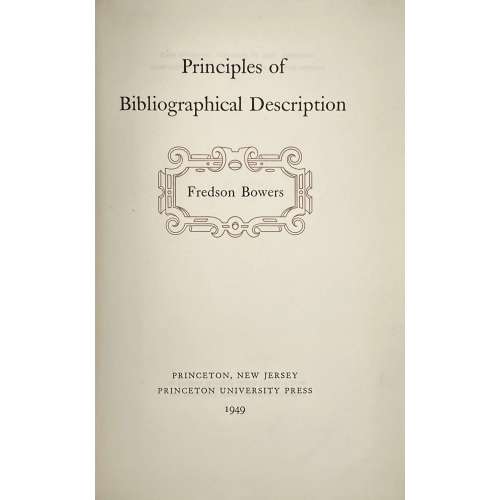 Detailed Bibliographical Description: ( Title: Principles of | Bibliographical Description | Fredson Bowers (in a frame) | PRINCETON, NEW JERSEY | PRINCETON UNIVERSITY PRESS | 1949. Pagination: [i-vii] viii-xvii [xviii] [1-3] 4-505 [506], 2 leaves of plates. Exterior: 24 x 16.5 cm, purple-grey cloth, brown label with gilt lettering to spine, DJ. Fredson Thayer Bowers (American, 1905 – 1991).
Detailed Bibliographical Description: ( Title: Principles of | Bibliographical Description | Fredson Bowers (in a frame) | PRINCETON, NEW JERSEY | PRINCETON UNIVERSITY PRESS | 1949. Pagination: [i-vii] viii-xvii [xviii] [1-3] 4-505 [506], 2 leaves of plates. Exterior: 24 x 16.5 cm, purple-grey cloth, brown label with gilt lettering to spine, DJ. Fredson Thayer Bowers (American, 1905 – 1991). -
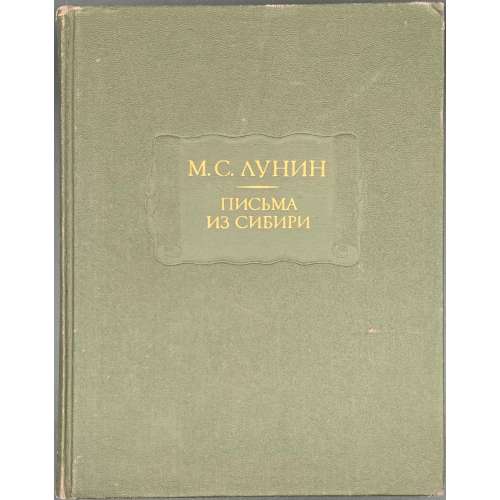 Title (black and red): М. С. ЛУНИН | — | ПИСЬМА ИЗ СИБИРИ | — | Издание подготовили | И. А. Желвакова и Н. Я Эйдельман | МОСКВА | «НАУКА» | 1987 || Pagination: [1, 2] Serial h.t. / blank, [3, 4] t.p. / imprint, [5] 6-492 [4], 1 portrait and 8 leaves of plates. Collation: 16mo; [1]16 216 38 (plates), 4-1716. Binding: serial green buckram blind-stamped with a scroll adorned with gold lettering to board and spine.
Title (black and red): М. С. ЛУНИН | — | ПИСЬМА ИЗ СИБИРИ | — | Издание подготовили | И. А. Желвакова и Н. Я Эйдельман | МОСКВА | «НАУКА» | 1987 || Pagination: [1, 2] Serial h.t. / blank, [3, 4] t.p. / imprint, [5] 6-492 [4], 1 portrait and 8 leaves of plates. Collation: 16mo; [1]16 216 38 (plates), 4-1716. Binding: serial green buckram blind-stamped with a scroll adorned with gold lettering to board and spine. -
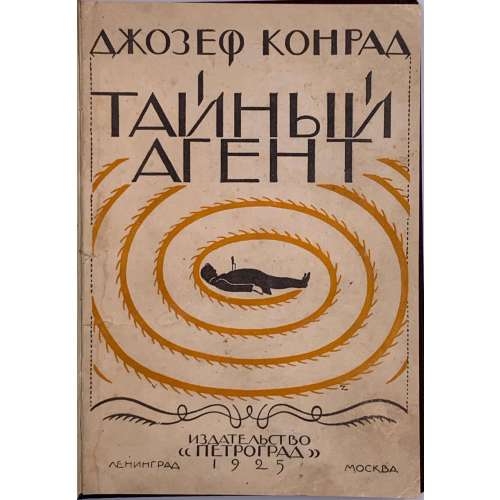 20 x 14.5 cm, owner’s burgundy buckram, upper original pictorial wrapper preserved, in black and yellow. Title: ДЖОЗЕФ КОНРАД | ТАЙНЫЙ АГЕНТ | (The secret agent) | Перевод с английского | М. МАТВЕЕВОЙ | под редакцией | В. А. АЗОВА | {device} | Издательство “ПЕТРОГРАД” | ЛЕНИНГРАД — МОСКВА | 1925. Pagination: ffl, [2] orig. wrapper/blank, [1, 2] t.p./imprint, 3-245 [3 advert.] Collation: 8vo; [1]8 2-158 164. Print run: 5.000 copies. Редактор перевода: В. А. Азов Contributors: Joseph Conrad (Polish-British, 1857 – 1924) – author. Владимир Александрович Ашкинази [Азов] (Russian-French, 1873 – 1941) – translator/editor. Марианна Николаевна Матвеева (Russian, 20th century) – translator. Original title: [LIB-2762.2021] Joseph Conrad. The secret agent: a simple tale. — London: Methuen & Co., [1907]; [LIB-3213.2023] Joseph Conrad. The secret agent: A drama in three acts. — London, T. Werner Laurie., 1923.
20 x 14.5 cm, owner’s burgundy buckram, upper original pictorial wrapper preserved, in black and yellow. Title: ДЖОЗЕФ КОНРАД | ТАЙНЫЙ АГЕНТ | (The secret agent) | Перевод с английского | М. МАТВЕЕВОЙ | под редакцией | В. А. АЗОВА | {device} | Издательство “ПЕТРОГРАД” | ЛЕНИНГРАД — МОСКВА | 1925. Pagination: ffl, [2] orig. wrapper/blank, [1, 2] t.p./imprint, 3-245 [3 advert.] Collation: 8vo; [1]8 2-158 164. Print run: 5.000 copies. Редактор перевода: В. А. Азов Contributors: Joseph Conrad (Polish-British, 1857 – 1924) – author. Владимир Александрович Ашкинази [Азов] (Russian-French, 1873 – 1941) – translator/editor. Марианна Николаевна Матвеева (Russian, 20th century) – translator. Original title: [LIB-2762.2021] Joseph Conrad. The secret agent: a simple tale. — London: Methuen & Co., [1907]; [LIB-3213.2023] Joseph Conrad. The secret agent: A drama in three acts. — London, T. Werner Laurie., 1923. -
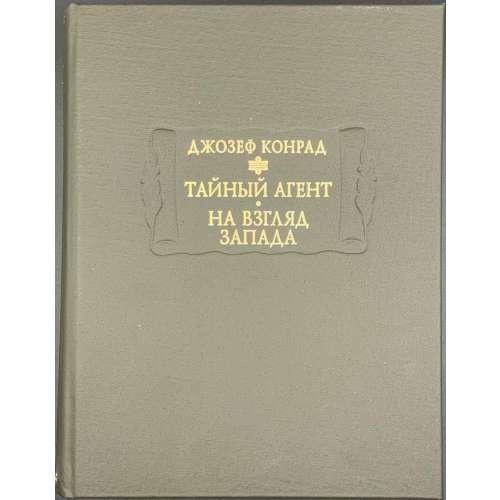 Title: ДЖОЗЕФ КОНРАД |{device} | ТАЙНЫЙ АГЕНТ | • | НА ВЗГЛЯД ЗАПАДА | • | Издание подготовил | В.М. ТОЛМАЧЕВ | Научно-издательский центр | «Ладомир» | «Наука» | Москва || Frontispiece: JOSEPH CONRAD |{device} | THE SECRET AGENT | • | UNDER WESTERN EYES || Pagination: [1-9] 10-595 [3] [2 advert.]. Binding: serial green cloth blind-stamped with a scroll adorned with gold lettering to board and spine, 22.5 x 17 cm. Original titles: [LIB-2762.2021] Joseph Conrad. The secret agent: a simple tale. — London: Methuen & Co., [1907]; [LIB-3213.2023] Joseph Conrad. The secret agent: A drama in three acts. — London, T. Werner Laurie, 1923.
Title: ДЖОЗЕФ КОНРАД |{device} | ТАЙНЫЙ АГЕНТ | • | НА ВЗГЛЯД ЗАПАДА | • | Издание подготовил | В.М. ТОЛМАЧЕВ | Научно-издательский центр | «Ладомир» | «Наука» | Москва || Frontispiece: JOSEPH CONRAD |{device} | THE SECRET AGENT | • | UNDER WESTERN EYES || Pagination: [1-9] 10-595 [3] [2 advert.]. Binding: serial green cloth blind-stamped with a scroll adorned with gold lettering to board and spine, 22.5 x 17 cm. Original titles: [LIB-2762.2021] Joseph Conrad. The secret agent: a simple tale. — London: Methuen & Co., [1907]; [LIB-3213.2023] Joseph Conrad. The secret agent: A drama in three acts. — London, T. Werner Laurie, 1923. -
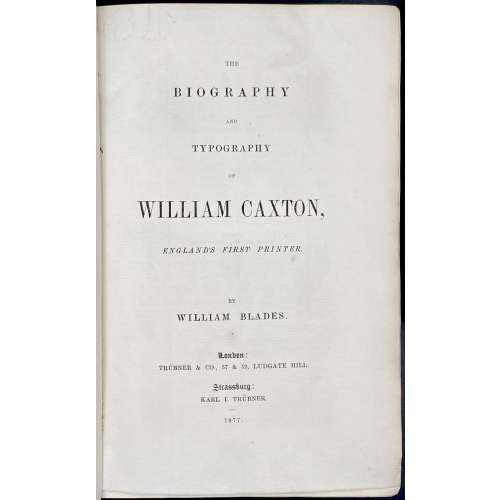 Title: THE | BIOGRAPHY AND | TYPOGRAPHY | OF | WILLIAM CAXTON, | ENGLAND'S FIRST PRINTER. | BY | WILLIAM BLADES. | LONDON : | TRÜBNER & CO, 57 & 59 LUDGATE HILL. | STRASSBURG : | KARL I. TRÜBNER. | 1877. || Pagination: ffl, [2] blank, [i, ii] - t.p., imprint, [iii], iv, v - preface, [vi] - cul-de-lampe, [vii], viii - contents; [1], 2-383 [384] - imprint, 2] - blanks, bfl.; 18 plates: op. p. 8, 22, 54 (3), 60, 126 (4), 283, [311], 336, 358 (5). Collation: 8vo; [A]4 B-Z8 AA8 BB7. Exterior: 22.6 x 14.8 cm, printed on watermarked Zanders laid paper, original brown decorated paper boards, spine with decoration and lettering, marbled end-papers, water stain to bottom of upper cover, slightly rubbed, upper margin marbled, other untrimmed, binder's mark to back pastedown: "Bound by Simpson & Renshaw". Bookplates to front pastedown: upper: F. Marcham | Tempora mutantur, nos et mutamur in illis. | Hornsey | 1907"; lower: (2) "From the library of | H. Harvey Frost". Caxton, William (British, c. 1422 – 1491). Blades, William (British, 1824-1890) Frank Marcham (1883 – 1934), motto: "Times are changed, we also are changed with them". This book is based on the author's The Life and Typography of William Caxton, London: J. Lilly, 1861-63, – "A new 'Life' in a more handy form".
Title: THE | BIOGRAPHY AND | TYPOGRAPHY | OF | WILLIAM CAXTON, | ENGLAND'S FIRST PRINTER. | BY | WILLIAM BLADES. | LONDON : | TRÜBNER & CO, 57 & 59 LUDGATE HILL. | STRASSBURG : | KARL I. TRÜBNER. | 1877. || Pagination: ffl, [2] blank, [i, ii] - t.p., imprint, [iii], iv, v - preface, [vi] - cul-de-lampe, [vii], viii - contents; [1], 2-383 [384] - imprint, 2] - blanks, bfl.; 18 plates: op. p. 8, 22, 54 (3), 60, 126 (4), 283, [311], 336, 358 (5). Collation: 8vo; [A]4 B-Z8 AA8 BB7. Exterior: 22.6 x 14.8 cm, printed on watermarked Zanders laid paper, original brown decorated paper boards, spine with decoration and lettering, marbled end-papers, water stain to bottom of upper cover, slightly rubbed, upper margin marbled, other untrimmed, binder's mark to back pastedown: "Bound by Simpson & Renshaw". Bookplates to front pastedown: upper: F. Marcham | Tempora mutantur, nos et mutamur in illis. | Hornsey | 1907"; lower: (2) "From the library of | H. Harvey Frost". Caxton, William (British, c. 1422 – 1491). Blades, William (British, 1824-1890) Frank Marcham (1883 – 1934), motto: "Times are changed, we also are changed with them". This book is based on the author's The Life and Typography of William Caxton, London: J. Lilly, 1861-63, – "A new 'Life' in a more handy form". -
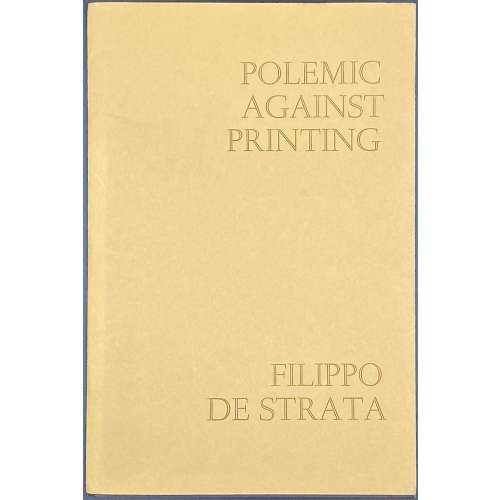 POLEMIC AGAINST PRINTING | by | FILIPPO DE STRATA | Translated by SHELAGH GRIER | Edited and | Introduced by MARTIN LOWRY | University of Warwick | The Hayloft Press | 1986 || Publisher’s mustard wrappers w/ lettering, 18.5 x 12.5 cm, 20 unnumbered pages of parallel Latin text and English translation with English introduction; limited edition of 350 copies, 100 for private circulation and 250 numbered copies for sale of which this is №3, with ink inscription to the last page: To Beryl | on her birthday, 1986 | with love from | David ||
POLEMIC AGAINST PRINTING | by | FILIPPO DE STRATA | Translated by SHELAGH GRIER | Edited and | Introduced by MARTIN LOWRY | University of Warwick | The Hayloft Press | 1986 || Publisher’s mustard wrappers w/ lettering, 18.5 x 12.5 cm, 20 unnumbered pages of parallel Latin text and English translation with English introduction; limited edition of 350 copies, 100 for private circulation and 250 numbered copies for sale of which this is №3, with ink inscription to the last page: To Beryl | on her birthday, 1986 | with love from | David || -
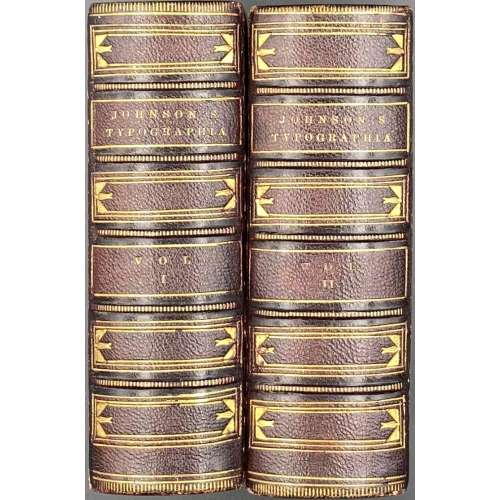 2 volume set, ¾ burgundy morocco over peacock marbled boards, ruled gilt, raised bands, gilt-ruled in compartments, gilt lettering, marbled endpapers and all margins, binding by W. S. Hiltz, NY. Vol. 1. Title: Typographia, | OR THE | Printers' Instructor: | INCLUDING AN ACCOUNT | of the | ORIGIN OF PRINTING, | with | Biographical Notices of the Printers of | England, from Caxton to the close | of the Sixteenth Century : | A Series of | Ancient and Modern Alphabets, | and | DOMESDAY CHARACTERS: | Together with | An Elucidation of every Subject con- | nected with the Art. | By J. JOHNSON, Printer. |{stanza}| Vol. I. | In frame: Published by Messrs. Longman, Hurst, | Rees, Orme, Brown & Green, Pater- | noster Row, London | Under the frame: 1824. || Pagination: Blank leaf, [2] – blank / engraved frontispiece (portrait of William Caxton by W. Hughes) w/guard, [2] – engraved t.p. by Thompson (upper margin almost none, tall lower margin, unframed) / blank, letterpress t.p. w/guard / blank, [2] – dedication to Earl Spenser and Roxburghe Club members / list of members, [2] – engraved Roxburgh Club plate by W. Hughes / blank, [4] – the pedigree of Earl Spenser, [i] ii-xii preface, [1] 2-610, [10] – index, blank leaf; printed on wove paper, text within double rule border. Vol. 2. Title: Typographia, | OR THE | Printers' Instructor: | INCLUDING AN ACCOUNT | of the | ORIGIN OF PRINTING, | with | Biographical Notices of the Printers of | England, from Caxton to the close | of the Sixteenth Century : | A Series of | Ancient and Modern Alphabets, | and | DOMESDAY CHARACTERS: | Together with | An Elucidation of every Subject con- | nected with the Art. | By J. JOHNSON, Printer. |{stanza}| Vol. II. | In frame: Published by Messrs. Longman, Hurst, | Rees, Orme, Brown & Green, Pater- | noster Row, London | Under the frame: 1824. || Pagination: Blank leaf, [2] – blank / engraved frontispiece (portrait of John Johnson ÆTATIS XLVI by William Harvey), w/o guard, [2] – engraved t.p. by G. W. Bonner (framed) / blank, letterpress t.p. w/o guard / blank, [2] – advert. / explanation of engraved title, [i]-iv contents, [1, 2] 3-663 [664], [14] – index, [2] – cantata, blank leaf; printed on wove paper, text within double rule border. Note: This is the book that served as a source of plagiarism for Adams's Typographia: a brief sketch of the origin, rise, and progress of the typographic art published in Philadelphia by himself in 1837.
2 volume set, ¾ burgundy morocco over peacock marbled boards, ruled gilt, raised bands, gilt-ruled in compartments, gilt lettering, marbled endpapers and all margins, binding by W. S. Hiltz, NY. Vol. 1. Title: Typographia, | OR THE | Printers' Instructor: | INCLUDING AN ACCOUNT | of the | ORIGIN OF PRINTING, | with | Biographical Notices of the Printers of | England, from Caxton to the close | of the Sixteenth Century : | A Series of | Ancient and Modern Alphabets, | and | DOMESDAY CHARACTERS: | Together with | An Elucidation of every Subject con- | nected with the Art. | By J. JOHNSON, Printer. |{stanza}| Vol. I. | In frame: Published by Messrs. Longman, Hurst, | Rees, Orme, Brown & Green, Pater- | noster Row, London | Under the frame: 1824. || Pagination: Blank leaf, [2] – blank / engraved frontispiece (portrait of William Caxton by W. Hughes) w/guard, [2] – engraved t.p. by Thompson (upper margin almost none, tall lower margin, unframed) / blank, letterpress t.p. w/guard / blank, [2] – dedication to Earl Spenser and Roxburghe Club members / list of members, [2] – engraved Roxburgh Club plate by W. Hughes / blank, [4] – the pedigree of Earl Spenser, [i] ii-xii preface, [1] 2-610, [10] – index, blank leaf; printed on wove paper, text within double rule border. Vol. 2. Title: Typographia, | OR THE | Printers' Instructor: | INCLUDING AN ACCOUNT | of the | ORIGIN OF PRINTING, | with | Biographical Notices of the Printers of | England, from Caxton to the close | of the Sixteenth Century : | A Series of | Ancient and Modern Alphabets, | and | DOMESDAY CHARACTERS: | Together with | An Elucidation of every Subject con- | nected with the Art. | By J. JOHNSON, Printer. |{stanza}| Vol. II. | In frame: Published by Messrs. Longman, Hurst, | Rees, Orme, Brown & Green, Pater- | noster Row, London | Under the frame: 1824. || Pagination: Blank leaf, [2] – blank / engraved frontispiece (portrait of John Johnson ÆTATIS XLVI by William Harvey), w/o guard, [2] – engraved t.p. by G. W. Bonner (framed) / blank, letterpress t.p. w/o guard / blank, [2] – advert. / explanation of engraved title, [i]-iv contents, [1, 2] 3-663 [664], [14] – index, [2] – cantata, blank leaf; printed on wove paper, text within double rule border. Note: This is the book that served as a source of plagiarism for Adams's Typographia: a brief sketch of the origin, rise, and progress of the typographic art published in Philadelphia by himself in 1837. -
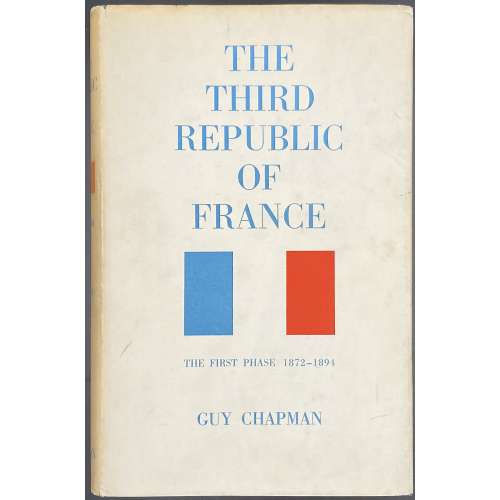 Title: THE | THIRD REPUBLIC | OF FRANCE | THE FIRST PHASE 1871–1894 | BY | GUY CHAPMAN | Sometime Professor of Modern History in the University of Leeds | LONDON | MACMILLAN & CO LTD | NEW YORK • ST. MARTIN’S PRESS | 1962 Pagination: [i-iv] v-xxii, [1] 2-433 [434 imprint]. Collation: 8vo; [A]8 B-Z8 2A-2D8 2E2 2E210. Binding: blue buckram, bronze lettering to spine, pictorial DJ. Publishing year 1963 according to worldcat. Author: Chapman, Guy Patterson (British, 1889 – 1972)
Title: THE | THIRD REPUBLIC | OF FRANCE | THE FIRST PHASE 1871–1894 | BY | GUY CHAPMAN | Sometime Professor of Modern History in the University of Leeds | LONDON | MACMILLAN & CO LTD | NEW YORK • ST. MARTIN’S PRESS | 1962 Pagination: [i-iv] v-xxii, [1] 2-433 [434 imprint]. Collation: 8vo; [A]8 B-Z8 2A-2D8 2E2 2E210. Binding: blue buckram, bronze lettering to spine, pictorial DJ. Publishing year 1963 according to worldcat. Author: Chapman, Guy Patterson (British, 1889 – 1972) -
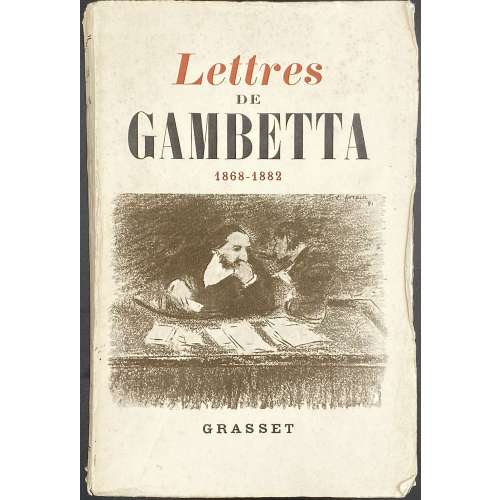 Title: LETTRES DE GAMBETTA | 1868 – 1882 | recueillies et annotées par | DANIEL HALÉVY ET ÉMILE PILLIAS | ÉDITIONS BERNARD GRASSET | 61, RUE DES SAINTS-PÈRES, VIe | PARIS || Collation: 8vo; [1]8 2-428, unpaginated, (336 leaves) + 4 leaves of plates extraneous to collation, untrimmed wove paper, 587 letters, printed on the 25th of March 1938 by Floch (Mayenne); limited edition, unnumbered copy. Binding: original publisher’s pictorial wrappers, lettering to spine. Series: "Documents", pub. sous la direction de la Société d'histoire de la troisième république. Insert: Lettre Autographe Signée (LAS): Ludovic Halévy (French, 1834 – 1908). Transcript:
Title: LETTRES DE GAMBETTA | 1868 – 1882 | recueillies et annotées par | DANIEL HALÉVY ET ÉMILE PILLIAS | ÉDITIONS BERNARD GRASSET | 61, RUE DES SAINTS-PÈRES, VIe | PARIS || Collation: 8vo; [1]8 2-428, unpaginated, (336 leaves) + 4 leaves of plates extraneous to collation, untrimmed wove paper, 587 letters, printed on the 25th of March 1938 by Floch (Mayenne); limited edition, unnumbered copy. Binding: original publisher’s pictorial wrappers, lettering to spine. Series: "Documents", pub. sous la direction de la Société d'histoire de la troisième république. Insert: Lettre Autographe Signée (LAS): Ludovic Halévy (French, 1834 – 1908). Transcript:Mercredi, Mon cher ami, Reçois mes bien sincères et bien affectueuses félicitations. Si tu continues à marcher de ce pas tu en seras bientôt en grande situation et ce sera justice, et j’en serais bien heureux n’en doute pas. Tout à toi Ludovic Halévy
Gambetta, Léon (French, 1838 – 1882). Halévy, Daniel (French, 1872 – 1962). Pillias, Émile (French, 1905 – 1940). -
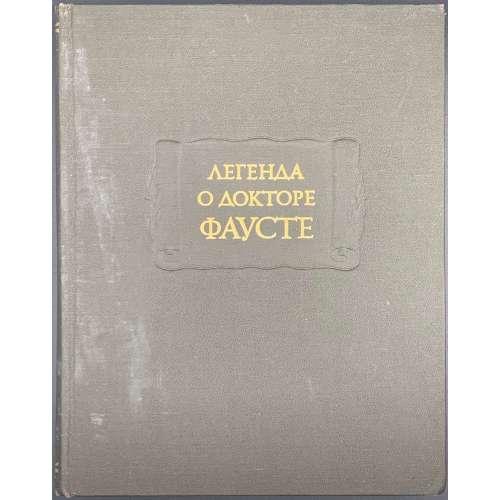 Title (black lettering, red elements): ЛЕГЕНДА | О ДОКТОРЕ | ФАУСТЕ | {element} | ИЗДАНИЕ ПОДГОТОВИЛ | В. М. ЖИРМУНСКИЙ | ВТОРОЕ, ИСПРАВЛЕННОЕ ИЗДАНИЕ | ИЗДАТЕЛЬСТВО «НАУКА» | МОСКВА 1978 || Pagination:[1-5] 6-421 [3]; +3 leaves of plates. Collation: 8vo; [1]8 2-278. Binding: 22 x 17.5 cm, serial green buckram blind-stamped with a scroll adorned with gold lettering to board and spine. Contents:
Title (black lettering, red elements): ЛЕГЕНДА | О ДОКТОРЕ | ФАУСТЕ | {element} | ИЗДАНИЕ ПОДГОТОВИЛ | В. М. ЖИРМУНСКИЙ | ВТОРОЕ, ИСПРАВЛЕННОЕ ИЗДАНИЕ | ИЗДАТЕЛЬСТВО «НАУКА» | МОСКВА 1978 || Pagination:[1-5] 6-421 [3]; +3 leaves of plates. Collation: 8vo; [1]8 2-278. Binding: 22 x 17.5 cm, serial green buckram blind-stamped with a scroll adorned with gold lettering to board and spine. Contents:- Исторические и легендарные свидетельства о докторе Фаусте / Пер. С. А. Акулянц.
- Народная книга: История о докторе Иоганне Фаусте, знаменитом чародее и чернокнижнике / Пер. Р. В. Френкель.
- Свидетельства о постановке народной драмы и кукольной комедии / Пер. С. А. Акулянц
- Кукольные комедии / Пер. H. A. Сигал: (1) Доктор Иоганн Фауст; (2) Доктор Фауст, или Великий Негромант; (3) Иоганнес Фауст.
- Кристофер Марло. Трагическая история доктора Фауста / Пер. H. H. Амосовой.
- «Фауст» Лессинга / Пер. В. Е. Гаккель-Аренс.
- Комментарии: В. М. Жирмунский. История легенды о Фаусте.
- Примечания / Сост. В. М. Жирмунский; к «Фаусту» Марло — H. H. Амосова.
-
![Юрий Масанов. В мире псевдонимов, анонимов и литературных подделок. / Под ред. и с вступ. ст. П. Н. Беркова. (Серия: Историко-литературные и биографические очерки). – М.: Издательство Всесоюзной книжной палаты, 1963. – pp.: [1-6] 7-318 [2], errata slip.](https://varshavskycollection.com/wp-content/uploads/2021/02/LIB-1589.2018-a-500x500.jpeg) Title: Ю. И. МАСАНОВ | В МИРЕ | ПСЕВДОНИМОВ, | АНОНИМОВ | И ЛИТЕРАТУРНЫХ | ПОДДЕЛОК | Под редакцией и со вступительной статьей | П. Н. БЕРКОВА | ИЗДАТЕЛЬСТВО ВСЕСОЮЗНОЙ КНИЖНОЙ ПАЛАТЫ | МОСКВА • 1963 || Frontispiece: ИСТОРИКО- | ЛИТЕРАТУРНЫЕ | И | БИОГРАФИЧЕСКИЕ | ОЧЕРКИ Pagination: [1-6] 7-318 [2], errata slip; 15 leaves of plates. Collation: 8vo; [1]8 2-208. Binding: 22.0 x 18 cm, hardcover; publisher's tan cloth, gilt arabesque to front board, brown labels with gilt lettering to spine; pictorial DJ. Масанов, Юрий Иванович (Russian, 1911 – 1965). Берков, Павел Наумович (Russian, (1896 – 1969).
Title: Ю. И. МАСАНОВ | В МИРЕ | ПСЕВДОНИМОВ, | АНОНИМОВ | И ЛИТЕРАТУРНЫХ | ПОДДЕЛОК | Под редакцией и со вступительной статьей | П. Н. БЕРКОВА | ИЗДАТЕЛЬСТВО ВСЕСОЮЗНОЙ КНИЖНОЙ ПАЛАТЫ | МОСКВА • 1963 || Frontispiece: ИСТОРИКО- | ЛИТЕРАТУРНЫЕ | И | БИОГРАФИЧЕСКИЕ | ОЧЕРКИ Pagination: [1-6] 7-318 [2], errata slip; 15 leaves of plates. Collation: 8vo; [1]8 2-208. Binding: 22.0 x 18 cm, hardcover; publisher's tan cloth, gilt arabesque to front board, brown labels with gilt lettering to spine; pictorial DJ. Масанов, Юрий Иванович (Russian, 1911 – 1965). Берков, Павел Наумович (Russian, (1896 – 1969).


